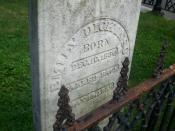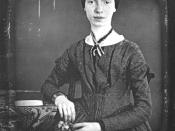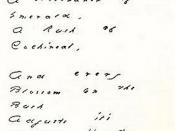Introduction
It comes as no surprise that the use and placement of words is incredibly important in the field of poetry. Through the use of metaphors and the assigning of words so specific places we are presented with images and often provided with powerful messages as well. With that in mind the following paper examines one of Emily Dickinson's poems, "My Life Had Stood-A Loaded Gun," in relationship to its language.
My Life Had Stood-A Loaded Gun
"Dickinson's...capitalized line, 'My Life had stood -- a Loaded Gun'" begins the poem that is filled with elements of language (Shoptaw). One critic, for example, illustrates that, "In the past, she 'had' stood in the corner, without a purpose. Then a hunter found her, knew her purpose since he was her 'Master,' and used her to express her purpose. The gun can be seen as language; the hunter's shooting-- the expression of the gun--is creating poetry" (Emily Dickinson). The doe, which is a female deer, "is hunted and presumably killed, just as women writers have to kill or suppress a part of themselves to write. Hunting in the wood re-establishes a relationship with nature, a frequent topic in Dickinson's poetry" (Emily Dickinson). It also gives a sense of control (the Woods are "Sovereign").
Her words, in essence, stand as metaphors for many different things, which is perhaps very obvious considering the title is clearly a powerful statement and use of words. Another critic dissects Dickinson's poem and offers the following: "The loaded gun, the volcanic face, the emphatic thumb-bullet are instruments of death. The poem tells of the release, channeled but exuberant, of pent-up aggression" (Emily Dickinson: Lecture).
We look at some of the lines and see how they are metaphors for one thing...


